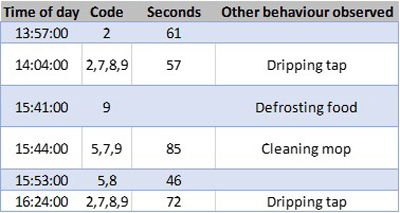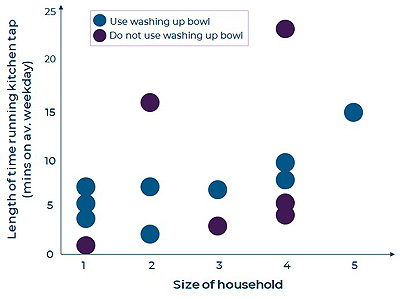The context
The discrepancies between reported and actual behaviour are long acknowledged. In the water sector, these challenges are particularly acute. Water use mainly involves routine and daily actions that are so embedded we barely notice them - and therefore respondents find it difficult to be accurate when answering retrospective questions about these behaviours. Additionally, social norms - particularly about wastefulness and hygiene - can result in respondents feeling self-conscious in a research situation, giving socially acceptable responses rather than discussing their true behaviour.
In countless other sectors, ethnographic approaches have shed light on real behaviours. The ability to observe consumers’ day-to-day behaviours over an extended period of time is becoming ever easier and cheaper thanks to the development of low-cost video technology.
Our approach
We adopted an innovative approach, drawing on our experience of using technology to observe other behaviours at close quarters.
Observing natural behaviour
Given the frequency and routine of kitchen sink activity, we decided to use motion-sensitive cameras in 15 households to capture real-life behaviours throughout day and night. As far as we are aware, the water sector has never previously used video technology to research household water usage.
Crucially, we wanted to use cameras which were unobtrusive, enabling us to get as close to natural behaviour as possible. We trialled several different cameras, using these in our own homes (and those of friends and family) until we were happy we had found the best option for this study. We selected a model with numerous advantageous features – including remote login (to allow moderators to review behaviour as fieldwork progressed), cloud storage (to facilitate easy access to the video clips) and night-vision (to ensure we did not miss any behaviours).

Figure 1: Eufy camera (Solo IndoorCam P24) that we used in this study
Adapting to the pandemic
The COVID-19 pandemic added an additional challenge - having initially planned to install the cameras in respondents’ homes ourselves (as part of in-home depth interviews), we now needed to ensure respondents would be able to set up the cameras by themselves, without a visit from our interviewers. Crucially, we needed to ensure this camera set-up would deliver the high-quality footage we were looking for.
We designed bespoke briefing packs to facilitate set-up and selected a camera which was particularly straightforward to install. We also arranged an initial depth interview (via video call) with each household prior to fieldwork, which we used to ensure that the camera was working as intended, as well as to gain participants’ trust. We also provided guidance regarding how to manage the presence of other people (who were not members of the household) on camera - including pointers on how to explain the research to friends and family, and how to ensure their consent for sharing any footage that might involve them.
Analysing actual behaviour
In order to understand how reported behaviour relates to actual behaviour, we logged and coded the video footage. Our team reviewed each clip to identify the behaviour involved (e.g. handwashing), coded it accordingly and recorded other relevant data (such as how long the kitchen tap ran for).
This process enabled us to analyse the video footage systematically and rigorously, developing valuable indicative statistics – such as the total length of tap running time in each household and the number of individual kitchen sink “events” in a single day. In total, we reviewed 150 days of kitchen sink behaviour across the 15 participating households.

Figure 2: Example of coding of video clips

Figure 3: Example of analysis of video data
Comparing with reported behaviour
We conducted video depth interviews before and after the observation period. We used the first interview to build rapport, put participants at ease and ensure the camera technology was working. Although we told respondents that we were interested in observing behaviour at the kitchen sink, we did not reveal at this stage that we were specifically monitoring water usage - as we wanted to ensure that the kitchen sink behaviour we observed was as natural as possible (and some of the behaviours that we observed, including several breaches of national COVID-19 lockdown rules, suggested that we managed to achieve this).
At the start of the second interview, we then asked respondents a series of standard industry questions about their kitchen sink water usage during the previous week (such as how many times a day they use the kitchen sink and how often they do the washing up). We compared participants’ responses with the data that we had gathered during the observation period.
Understanding the behaviour we observed
Where we identified significant discrepancies between reported and actual behaviour, or observed unusual behaviours, we presented some of these to the participants in the second interview. We asked them to talk us through short video clips, explaining the rationale behind their actions. In some instances, we showed participants footage of their own behaviours - particularly where their survey responses had not mentioned “bad” kitchen sink behaviours. This provided powerful footage which we have used in the research film, akin to a water industry Gogglebox (see film below). Some participants reacted with surprise or shock at the video clips (highlighting the extent to which much kitchen sink behaviour is largely subconscious), while others became defensive (underlining the value of observational approaches).
Next steps
Following on from this project, several water companies are now collaborating with Blue Marble on a follow-up study exploring garden water usage during the hot summer months - suggesting that we have succeeded in sparking industry interest in greater use of observational techniques.
For more information on this research:
Author biography
Tom Clarkson is a Research Director at Blue Marble. Tom was previously at BritainThinks and Savanta ComRes. Tom has led major studies for clients including Defra, the Home Office, Thames Water, Citizens Advice and the Financial Conduct Authority.
Acknowledgements
Huge thanks to the team at CCW for their support throughout this study.